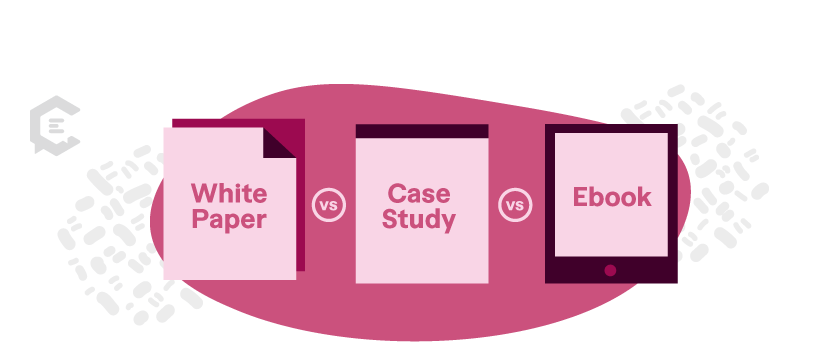Long-form content is all the same, right? Not exactly. When it comes to white papers, case studies, and ebooks, the differences are important to know to ensure you focus on the most beneficial format for your readers and brand.
We’re exploring what makes each unique below and how to make them a part of your content strategy.
White papers, case studies, and ebooks: What’s the difference?
The importance of this story is that brands must be familiar with and understand when to use different content formats. However, trying to figure out when to use white papers vs. case studies vs. ebooks can be confusing.
This is partly because these three formats are considered interchangeable because they share the following characteristics:
- They’re primarily created as long-form content (with a minimum of 1,500 words)
- They’re highly useful for moving prospects along the marketing funnel, especially along the top or middle of the funnel
- They’re great for boosting brand awareness and gathering prospect information
- All three should be targeted to specific personas and target audiences
And… those are the only things white papers, case studies, and ebooks have in common. As the following demonstrates, the three content formats have different purposes and uses, and require different development techniques.
White papers: Academic persuasion, formal style
When it comes to white papers vs. case studies vs. ebooks, the classic white paper could be considered the scholastic tool of the business content world. Its goal is to help position an individual or corporate entity as an authority on an industry topic, product, service, or any other subject.
To succeed in this, a well-crafted white paper needs to provide persuasive, factual information about a particular product or subject matter.
This means that your white paper is more than an opinion created by an in-house marketing department. In fact, opinions shouldn’t make their way into white papers. A reputable white paper should contain facts as well as focused and original research. Where to find this research? Your client might have it on hand from focus groups or surveys. Or you could be asked to examine academic literature or data-rich websites.
When to use
White papers are ideal when it comes to building trust and credibility with your audience. They’re used when companies want to explain industry trends, predictions, or forecasts backed by well-sourced, primarily academic, information. Your white paper will likely be used to increase top-of-mind awareness among your prospects and clients by demonstrating expertise and impressive knowledge.
Best practices
Here are points to consider when writing a white paper:
- Watch your tone. White papers should be constructed in a highly academic, very professional tone. Always use third-person language.
- Back up points with facts. Again, white papers aren’t containers for opinions. Take the time to conduct independent research, and be sure to source it. This can be done with footnotes, end notes, or in-parenthetical citations.
- Be sure to position the content, so it’s readable. The white paper’s tone is conservative. But the layout needs to be easy to read. Use headings, subheads, and bullet points to ensure readers can easily digest the content.
Case studies: Defining problems, providing solutions
Unlike white papers or ebooks, case studies are a hard-sell tool, and they don’t need academic information to succeed. This is because case studies introduce a specific problem, discuss how a company’s product or service can solve that problem, and then focus on the results of that usage. Most times, case studies rely on real-world specifics when it comes to solving a client’s problem or challenge.
Successful case studies are generally divided into four sections:
- The challenge or problem
- The product/service offered
- The solution (used by the specified product/service)
- The successful results, thanks to the solution
The goal of case study content is to demonstrate to prospects that a particular product or service can solve problems and how it does so.
When to use
Use case studies when you want to showcase a particular product or service and demonstrate how it solves a challenge or issue. This content format is a great testimonial in that prospects that read it can understand how the mentioned product or service can solve their own problems.
Best practices
When writing up your case study, consider the following:
- Brush up your persuasive style. Again, out of the three types of longer-form content, your case study will be higher on the “hard-sell” style. The focus here is to convey that, as a product or service helped a client, it can help the reader as well.
- Highlight a problem similar to what your prospects face. To fully appreciate the benefits of the solution, readers need to know that the presented problem relates to what they’re going through.
- Use visual appeal. Rely on headers and footers to divide text and bulleted/numbered lists to provide information. Callouts are especially effective in case studies.
- List the data. Simply suggesting that a solution doubled a client’s website traffic or sales figures isn’t enough. Be specific with the numbers, so readers understand the solution’s impact.
Ebooks: Deep dives into topics of choice
Finally, when examining the differences between white papers vs. case studies. vs. ebooks, consider how the latter is used. Ebooks consist of content on digital pages that are meant to be viewed on a computer, tablet, or smartphone, though they can also be printed out as hard copies.
What does that content consist of? Well, pretty much anything the company wants it to. An ebook can be a straight marketing piece, complete with an in-depth explanation of a corporate product or service. It can also be a strict informational piece to demonstrate a company’s industry knowledge and trends — or it can be a combination of the two.
It can also teach your audience how to do something that directly or indirectly relates back to a product or service you sell.
Unlike the academic white paper or solutions-oriented case study, the ebook is long-form marketing content that is highly versatile, and used for a variety of content marketing purposes.
The ebook goes beyond the space and length of a blog, providing prospects with in-depth information about a particular topic. In this way, a company can position itself more effectively to a target audience.
When to use
Ebooks should be used when you have a specific story to tell, one that needs more space and length than what can be provided through a short-form blog or on a corporate website. In addition, ebooks can be used as guides to show prospects how to get from a point of origin to a particular goal.
Best practices
What follows are best practices when it comes to crafting an ebook:
- Make it valuable to the audience. Specifically, the information provided should be interesting to your readers, and higher level or more in-depth than what might be found in a website blurb or short-form blog post. Your ebook should provide actionable advice, specific details, and thorough information when it comes to the topic at hand.
- Use plenty of visuals. Similar to other long-form content types, it’s important to break apart the editorial content through the use of headers, subheads, bullet points, numbered lists, and callouts. Ebooks are also ideal foundations for videos, graphs, charts, and infographics.
- Use a “business casual” conversation style. Remember that an ebook isn’t an academic treatise or stilted presentation. You can be a little informal in this case, and rely on a more relaxed style of writing to engage readers.
Long-form content is a powerful tool
White papers, case studies, and ebooks can be invaluable additions to any content strategy plan. But successful incorporation of these content formats requires insight into their use, purpose, and creation.
Taking the time to understand the differences between white papers, case studies, and ebooks will help you potentially become a better, highly regarded content producer.
White papers vs. case studies vs. ebooks — what’s right for your brand? Talk to a content specialist at ClearVoice today about creating a long-form content strategy for your brand.






